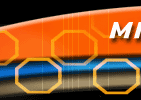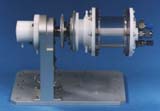




There are three primary advantages in using a space station for scientific research:
- Microgravity
- Vacuum
- Radiation
One of the primary roles of the Space Station 2020 is bio-medical research. This includes:
- The manipulation of organic materials - cells, tissues, and living organisms
- development of organic computer components
- produce large, near perfect protein crystals
- research on insulin
- producing antibiotics using plant cell cultures
- improvement of ground-based antibiotic production.
- cardiac muscle tissue engineering
- manufacture of special drugs such as Interferon

Glovebox
One of the most useful pieces of experimental equipment
that is carried by the Space Shuttle and the International Space Station
is the Glovebox. The Glovebox Experiment Module was designed and
built in the United Kingdom by the Brunel Institute for Bio-engineering.
The Glovebox is an enclosed cabinet with hand access via rubber gloves
integrated into the box, and a viewing panel to permit the viewer to see
what he or she is doing. Fluids, powders, bioproducts, toxins
and irritants are among the materials used by researchers during their
investigations.

Bioreactor
Bioreactors are closed containers for biological processes.
They provide a completely controllable environment for the processes
to take place. They may be heated, cooled or pressurized.
Chemicals or additional biological materials to be added and the progress
of the processes monitored. In the future they will play an important
role in bio-technology both on Earth and in space. Successes in
space have been achieved aboard the Mir
Space Station in 1996 when cartilage was grown in a bioreactor.
This was the first tissue-engineering experiment in space. The image
here shows a recently developed rotating wall bioreactor vessel.
For clarity it is shown without its support equipment.
© All images NASA
Go
to
Home
| Space Station
| Mars | Rainforest
© 1999 Satellite Events Enterprises Inc.
